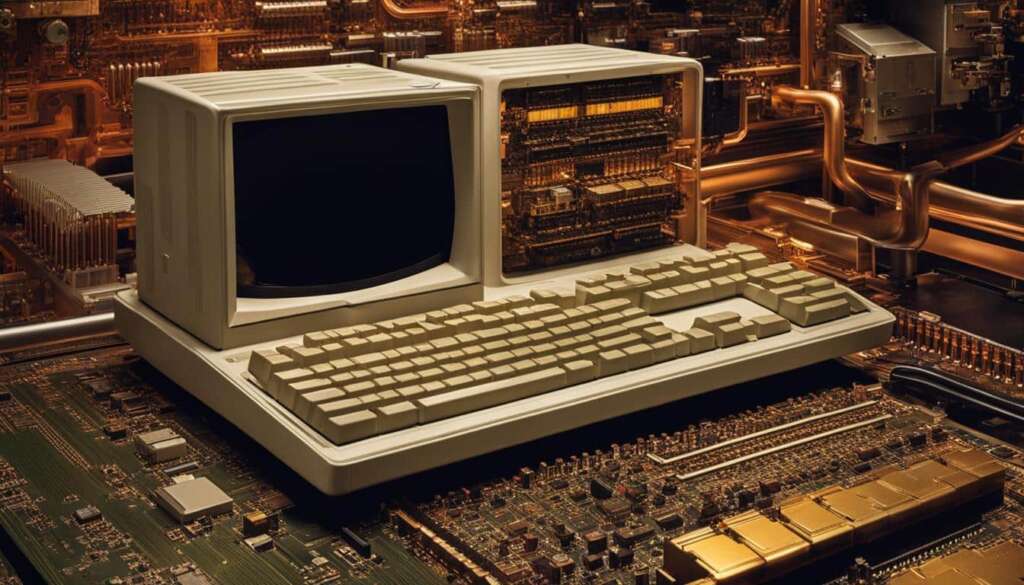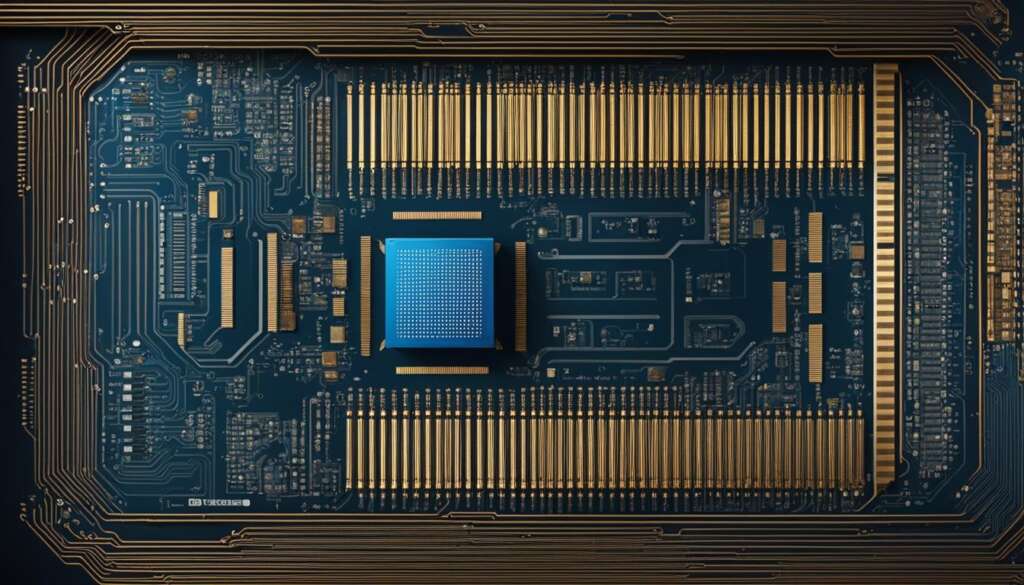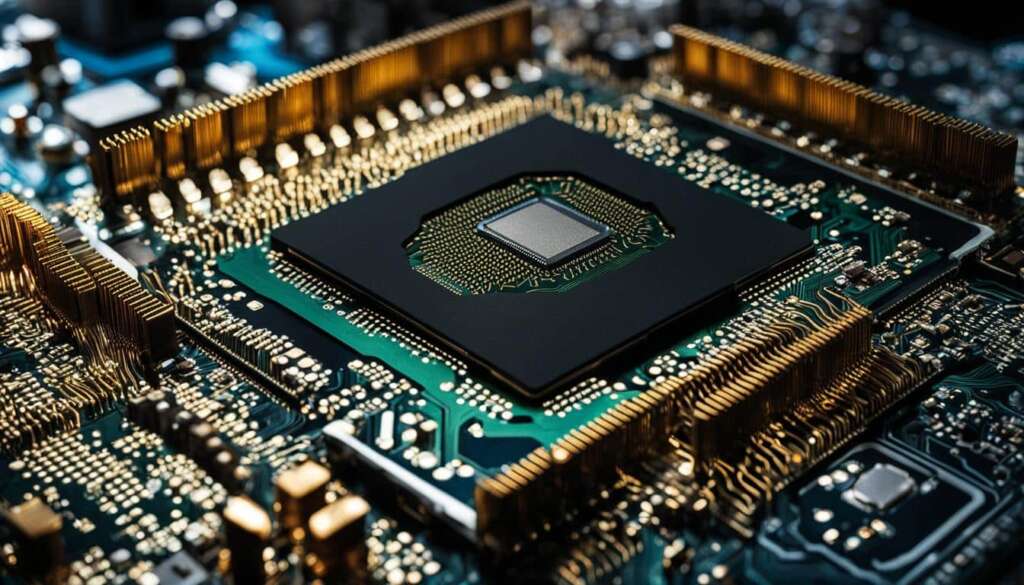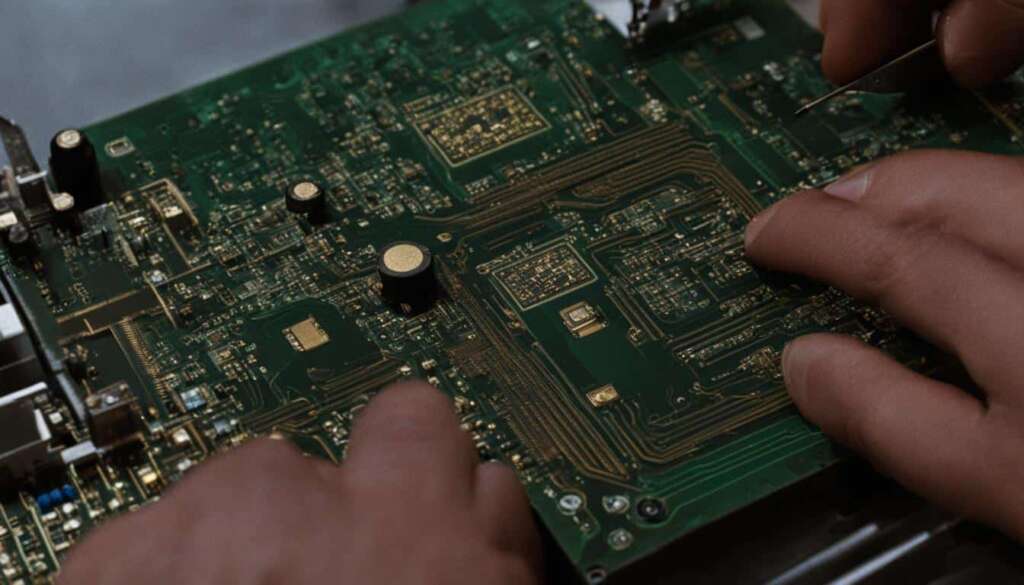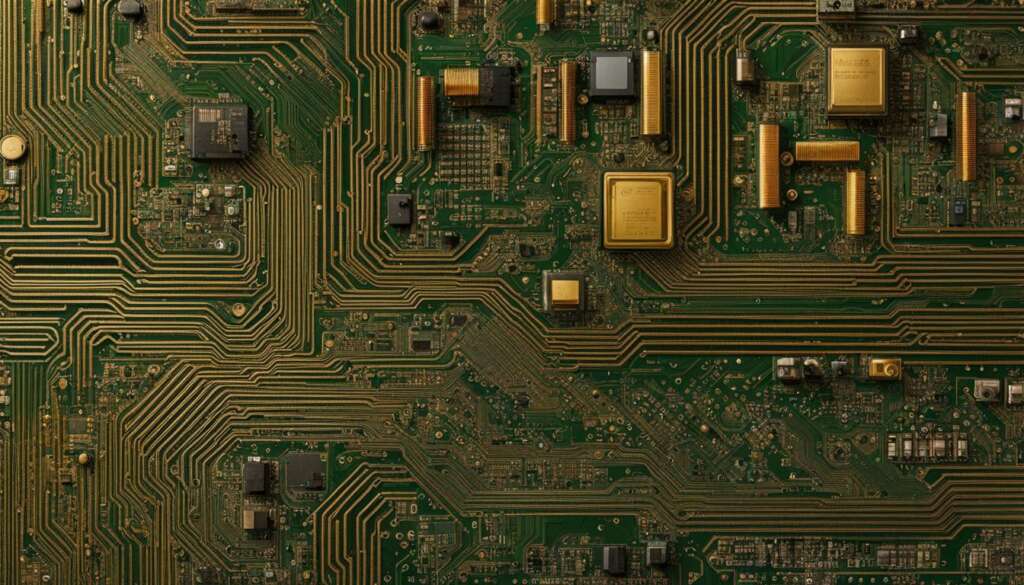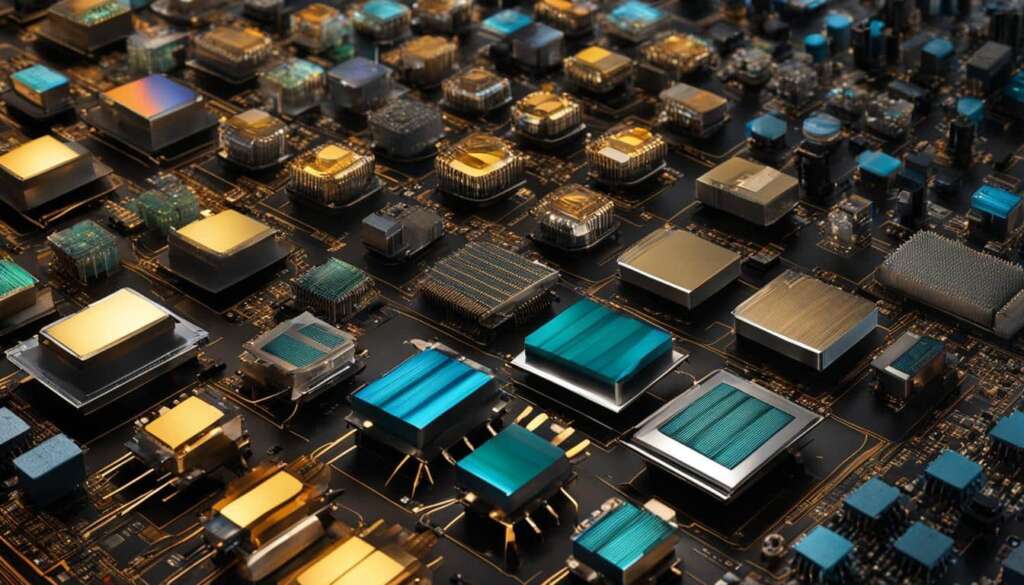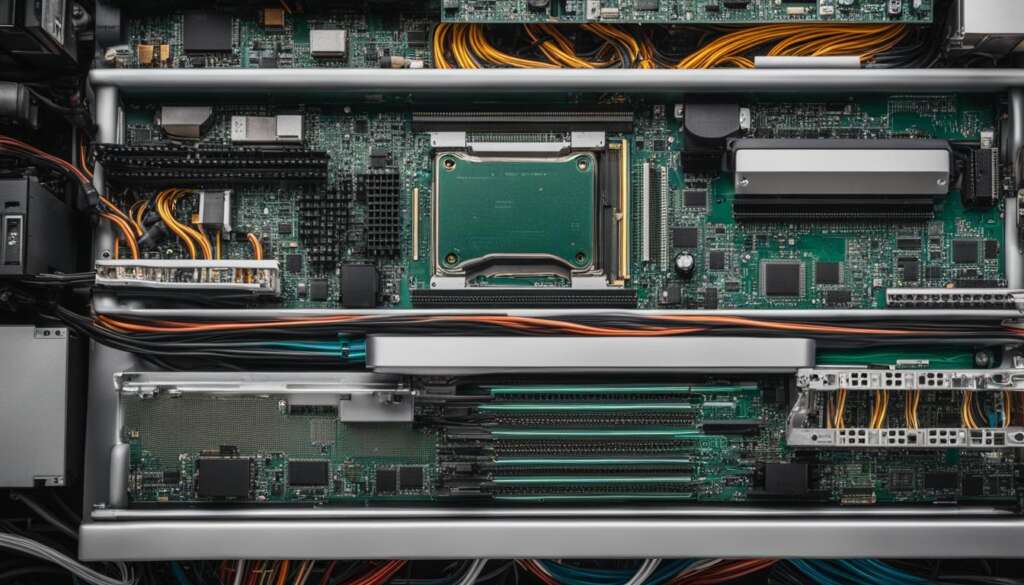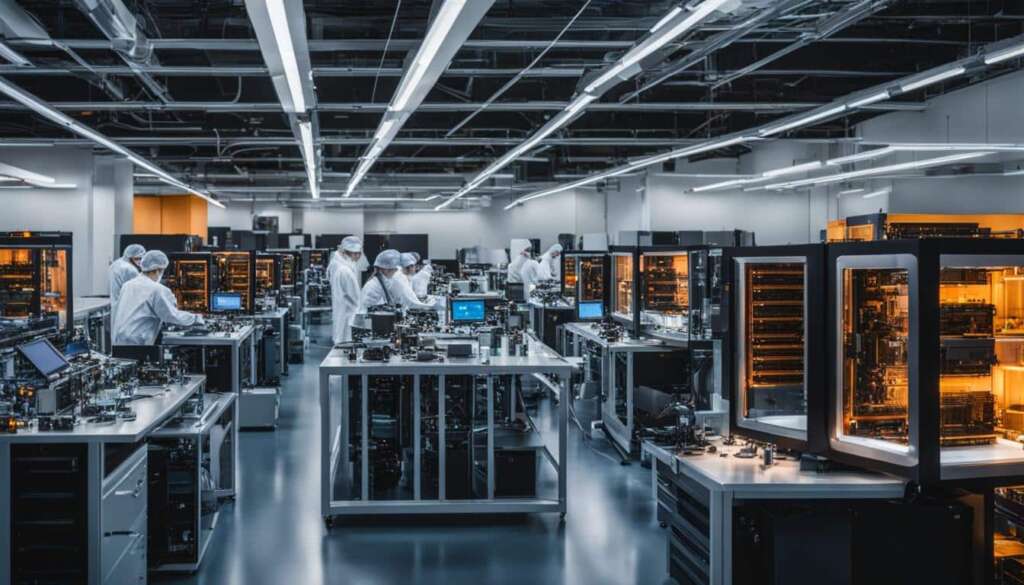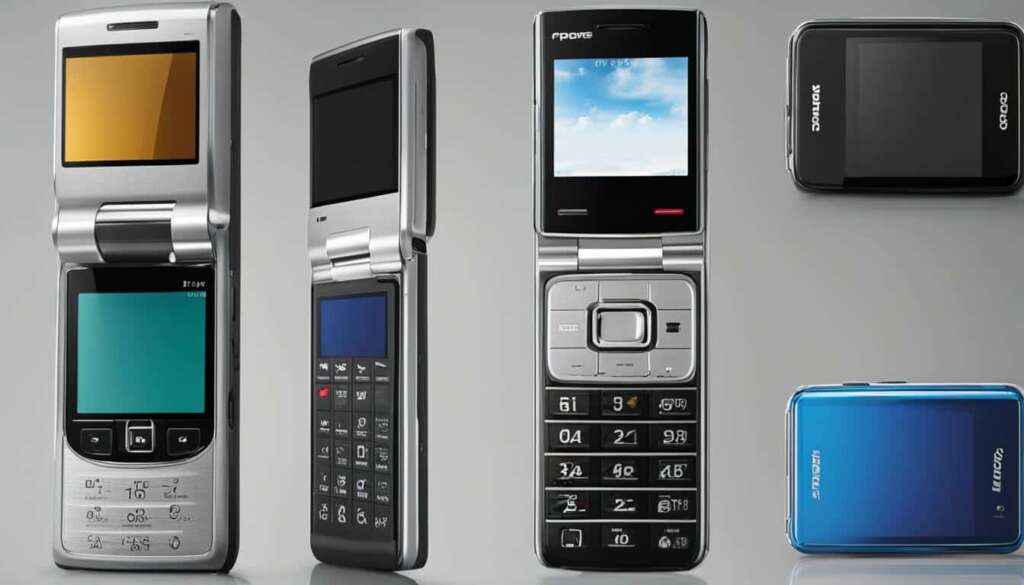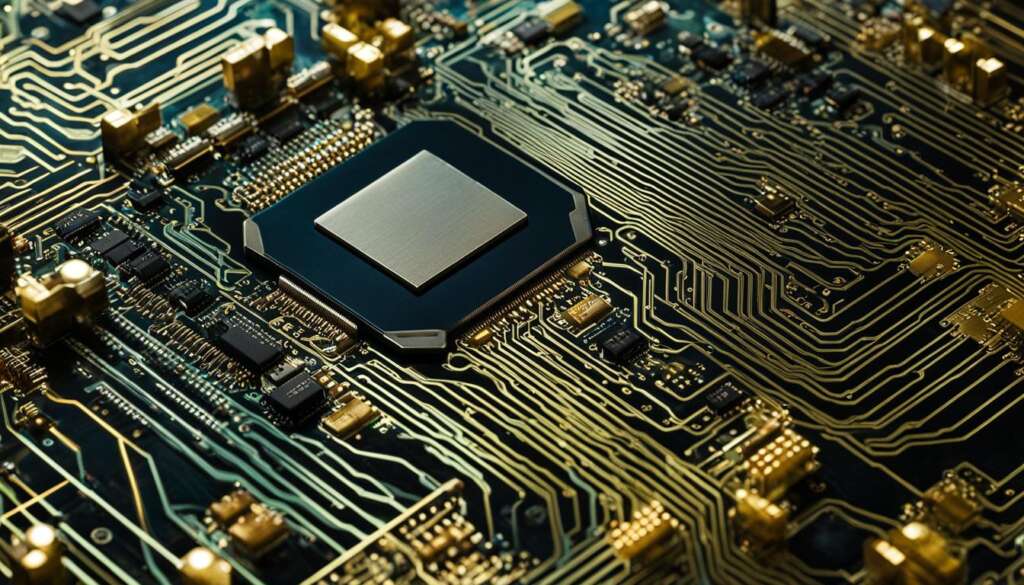Table of Contents
The history of computing can be traced back to the first generation of computer processors. These groundbreaking microprocessors, such as the Intel 4004, paved the way for the technological advancements we enjoy today. Let’s delve into the history of first-generation processors and understand their significant contributions to the field of computing.
The first generation processors, also known as microprocessors, were introduced by Intel in 1971. These processors revolutionized the world of computing by bringing processing power to smaller devices and making computing more accessible. Before the introduction of Intel’s microprocessor, processors like the Z-80 and 6502 were widely used in personal computers.
The 8080 processor, which powered the first personal computer, the Altair 8800, played a crucial role in starting the PC revolution. It marked the beginning of Intel’s dominance in the processor market, shaping the industry as we know it today.
The first generation of processors laid the foundation for future advancements, introducing new instructions, addressing modes, and architectural designs. These processors had a limited memory capacity and relatively low clock speeds, but they brought us closer to the powerful and efficient computers we use today.
Join us as we explore the importance, features, advantages, disadvantages, and evolution of first-generation processors. From their humble beginnings to their lasting legacy, first-generation processors continue to shape the technology-driven world we live in.
Features of First Generation Processors
The first generation of processors, also known as microprocessors, introduced several key features that set them apart from previous computing technologies. These features were instrumental in shaping the early stages of computer development and paved the way for future advancements in processing power, memory capacity, and versatility.
8-bit Architecture
One notable feature of first-generation processors was their use of 8-bit architecture. This means that these processors were designed to process data in 8-bit chunks, allowing for relatively simple calculations and operations. Although limited by today’s standards, the introduction of 8-bit architecture was a significant step forward in the evolution of computing technology.
Limited Memory Capacity
First-generation processors had limited memory capacity, typically ranging from 640 bytes to 64KB. This constraint meant that these processors were only capable of handling relatively small amounts of data at a time. However, at the time of their introduction, this memory capacity was considered sufficient for performing basic computing tasks and running early computer programs.
Low Clock Speeds
Another distinguishing feature of first-generation processors was their relatively low clock speeds. For example, the Intel 4004 operated at a clock speed of 108KHz, while the 8080 ran at 2MHz. These clock speeds were sufficient for the computational needs of the time but are significantly slower compared to modern processors.
In addition to these key features, first-generation processors also introduced new instructions and addressing modes, making them more versatile and adaptable to various computing tasks. These early processors paved the way for the development of more advanced generations of processors that continue to shape the technology we rely on today.
| Features | Benefits |
|---|---|
| 8-bit Architecture | – Simplicity in calculations and operations – The foundation for future advancements |
| Limited Memory Capacity | – Sufficient for early computing tasks – Allowed for the running of basic programs |
| Low Clock Speeds | – Adequate for the computational needs of the time – Slower compared to modern processors |
| New Instructions and Addressing Modes | – Increased versatility and adaptability to various computing tasks |
Importance of First Generation Processors
The first generation of processors, also known as microprocessors, played a vital role in the development and evolution of modern computing. These pioneering processors laid the foundation for future advancements in technology and set the stage for the technology-driven world we now live in.
One of the key factors contributing to the importance of first-generation processors was their introduction of the concept of a microprocessor. Before these processors, computers relied on multiple separate components for processing, memory, and control functions. The integration of these functions into a single microprocessor revolutionized the industry by making computing more accessible and affordable.
Furthermore, the market dominance of Intel in the first-generation processor era set the stage for future competition and innovation. Intel’s introduction of the 4004 microprocessor in 1971 marked the beginning of their dominance in the processor market. This paved the way for future generations of processors and solidified Intel’s position as a leading force in the industry.
| Advantages of First Generation Processors | Disadvantages of First Generation Processors |
|---|---|
|
|
Overall, the importance of first-generation processors lies in their pivotal role in the development and advancement of computing technology. These processors introduced the concept of a microprocessor and demonstrated its potential, making computing more accessible to a wider audience. They laid the groundwork for future generations of processors, leading to exponential growth in processing power, memory capacity, and architectural design. The legacy of first-generation processors continues to shape the technology-driven world we live in today.
The first generation of processors laid the foundation for future advancements in technology and set the stage for the technology-driven world we now live in.
Advantages of First Generation Processors
The first generation of processors brought a range of advantages that revolutionized the computing industry. From their compact size and low cost to improved processing speed and memory capacity, these processors laid the foundation for modern computing technology.
Improved Processing Speed and Memory Capacity
One of the key advantages of first-generation processors was the significant improvement in processing speed compared to previous computing technologies. Although their clock speeds may seem slow by today’s standards, they were groundbreaking at the time. For example, the Intel 4004 operated at 108KHz and the 8080 at 2MHz, enabling faster data processing and calculations.
Additionally, first-generation processors introduced increased memory capacity, ranging from 640 bytes to 64KB. This expansion allowed for the handling of more complex tasks and larger datasets, making them more versatile than previous computing technologies.
Compact Size and Low Cost
Another advantage of first-generation processors was their compact size and affordability. The integration of multiple electronic components into a single chip reduced the physical footprint of computer systems and made them more accessible to a wider audience.
Furthermore, the compact size of these processors contributed to cost reduction. Manufacturing and assembling smaller chips required fewer materials and resources, resulting in more affordable computing devices. This affordability played a significant role in the widespread adoption of personal computers and the subsequent democratization of computing technology.
Backward Compatibility and Versatility
First-generation processors offered backward compatibility, allowing for the seamless transition from older computing systems to newer ones. This compatibility ensured that software and programming languages developed for previous computing technologies could still be used, minimizing disruption and enabling a smoother transition to more advanced systems.
Additionally, the introduction of new instructions and addressing modes enhanced the versatility of first-generation processors. These advancements expanded the range of tasks that could be performed by the processors, making them suitable for a broader array of applications and laying the groundwork for future innovations in computing technology.
| Advantages of First Generation Processors |
|---|
| Improved processing speed |
| Increased memory capacity |
| Compact size and low cost |
| Backward compatibility |
| Versatility |
Overall, the first generation of processors brought significant advantages to the computing industry. Their improved processing speed, increased memory capacity, compact size, low cost, backward compatibility, and versatility set the stage for the development of more advanced and powerful processors in subsequent generations.
Disadvantages of First Generation Processors
The first generation of processors, while groundbreaking for their time, also had their fair share of disadvantages that limited their capabilities and hindered their performance. These limitations are important to understand in order to appreciate the advancements made in subsequent generations of processors.
1. Limited Processing Speed
One of the major disadvantages of first generation processors was their relatively low processing speeds. Compared to modern processors, these early microprocessors operated at much slower clock speeds, which restricted their ability to handle complex computations efficiently. As a result, tasks that required significant processing power took considerably longer to complete on first generation processors.
2. Restricted Memory Capacity
Another drawback of first generation processors was their limited memory capacity. These early processors had smaller memory sizes compared to the gigabytes of memory available in modern systems. The restricted memory capacities of these processors meant that they could only handle a limited amount of data at a time, which in turn limited the complexity and scale of tasks that could be performed.
3. Complex Programming Requirements
The architectural designs of first generation processors were not as refined as later generations, resulting in more complex programming requirements. Programmers had to work with limited instruction sets and addressing modes, making software development for these processors more challenging. This complexity led to longer development cycles and increased costs for software projects.
Despite these disadvantages, the first generation of processors paved the way for future advancements in computing technology. The limitations faced by these early processors prompted engineers and scientists to develop more powerful, efficient, and versatile processors in subsequent generations, leading to the technological advancements we enjoy today.
| Disadvantages | |
|---|---|
| 1. Limited Processing Speed | First generation processors operated at relatively low clock speeds, resulting in slower computations for complex tasks. |
| 2. Restricted Memory Capacity | These processors had limited memory sizes, restricting the amount of data that could be processed at once. |
| 3. Complex Programming Requirements | The architectural designs of first generation processors necessitated more complex programming, leading to longer development cycles and increased costs. |
Evolution of Processors
The evolution of processors has been a remarkable journey that has continually pushed the boundaries of computing capabilities. Each generation of processors has brought significant advancements in processing power, memory capacity, and architectural design, leading to more powerful and efficient computers.
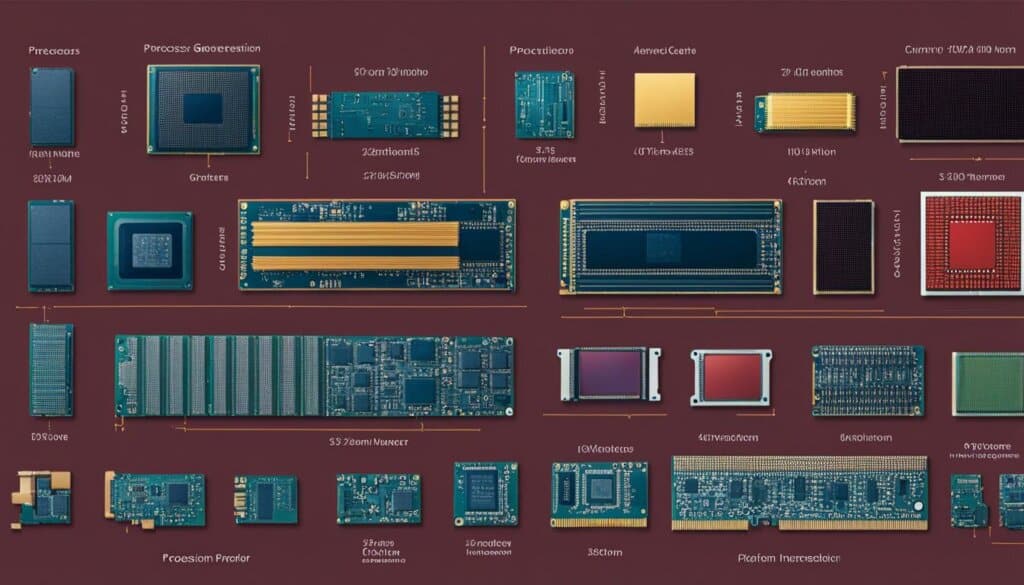
“The pace of innovation in the processor industry is truly awe-inspiring. With each new generation, we witness exponential growth in computing power and the ability to perform increasingly complex tasks.” – Industry Expert
Throughout the years, processors have become faster, smaller, and more energy-efficient. They have also become more versatile, capable of handling a wide range of applications and tasks. The introduction of multi-core processors has further enhanced performance, allowing for parallel processing and improved multitasking capabilities.
| Generation | Key Advancements |
|---|---|
| Second Generation | Transistors, smaller size, faster speeds |
| Third Generation | Integrated Circuits (ICs), increased memory capacity |
| Fourth Generation | Microprocessors, personal computers |
| Fifth Generation | Supercomputers, artificial intelligence |
Today, we stand on the cusp of a new era in processor technology. The sixth generation promises even greater advancements, with the development of technologies such as quantum computing and neuromorphic processors. These breakthroughs have the potential to revolutionize the way we process information and solve complex problems.
The Future of Processors
As technology continues to evolve, the future of processors looks incredibly promising. We can expect to see processors becoming even more powerful, efficient, and intelligent. The integration of artificial intelligence and machine learning into processors will enable computers to learn and adapt in real-time, opening up new possibilities in areas such as autonomous vehicles, healthcare, and robotics.
“The future of processors is limitless. We are entering an era where computers will be able to perform tasks that were once considered impossible. The advancements in processor technology will continue to shape our world and drive innovation across industries.” – Tech Enthusiast
In conclusion, the evolution of processors has been characterized by continuous innovation and remarkable advancements. From the early days of microprocessors to the current era of multi-core processors, each generation has brought us closer to the realization of truly powerful and intelligent computing systems. The future holds even greater potential as we embrace groundbreaking technologies that will shape the world of tomorrow.
First Generation CPU
The first generation of CPUs, or central processing units, marked a significant milestone in the evolution of computing technology. These early microprocessors, such as the Intel 4004, 8008, and 8080, were the building blocks of early computer systems, introducing the concept of a microprocessor and paving the way for future advancements in technology.
With the introduction of the Intel 4004 in 1971, the era of microprocessors began. These CPUs were instrumental in bringing computing power to smaller devices and making computing more accessible to a wider audience. The Intel 8008 and 8080 processors further expanded the capabilities of early personal computers, setting the stage for the future development of more powerful and efficient processors.
| CPU Model | Year Introduced |
|---|---|
| Intel 4004 | 1971 |
| Intel 8008 | 1972 |
| Intel 8080 | 1974 |
These early CPUs played a crucial role in the development of modern computing by laying the groundwork for future advancements in processing power, memory capacity, and software development. The legacy of first-generation CPUs continues to shape the future of computing, with each new generation building upon the innovations and advancements of the past.
First Generation Computer Processors
The first generation of computer processors, also known as microprocessors, played a significant role in shaping the modern computing industry. These early chips, such as the Intel 4004 and 8080, introduced the concept of a microprocessor and set the stage for future advancements in processing power, memory capacity, and software development.
One of the key features of first-generation processors was their 8-bit architecture, allowing them to process data in 8-bit chunks. This brought about improvements in processing speed and memory capacity, making these processors more versatile than previous computing technologies.
“The first generation of computer processors revolutionized the industry by introducing the concept of a microprocessor and demonstrating its potential.”
The compact size and low cost of first-generation processors made computing more accessible and affordable, leading to the widespread adoption of personal computers. Additionally, these processors offered backward compatibility with older software and programming languages, ensuring a seamless transition to newer systems.
While first-generation processors had some limitations, such as lower processing speeds and limited memory capacity, their contributions to the field of technology cannot be overlooked. These processors laid the foundation for future generations of processors, paving the way for the exponential growth in computing power and the development of more advanced and sophisticated processors.
| Advantages of First Generation Processors | Disadvantages of First Generation Processors |
|---|---|
|
|
Overall, the first generation of computer processors laid the foundation for the technology-driven world we live in today. Their impact and contributions continue to shape the future of computing, as new generations of processors build upon the advancements and innovations of the past.
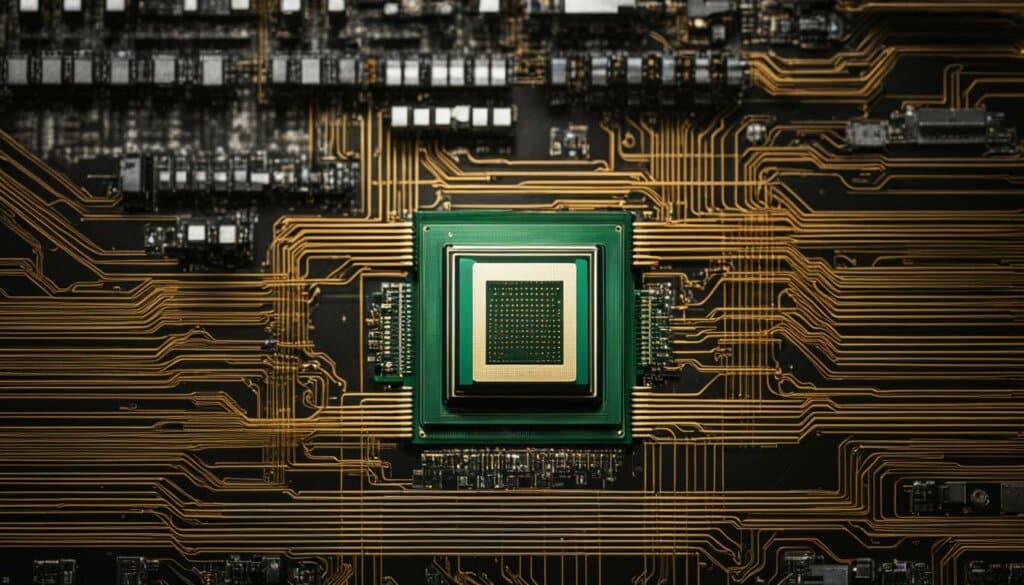
History of First Generation Processors
The history of first-generation processors can be traced back to the early 1970s when Intel introduced the 4004 microprocessor. This groundbreaking invention marked the beginning of the microprocessor revolution and paved the way for the development of modern computing technology. The 4004 microprocessor, with its 2,300 transistors, was a significant advancement in chip design at the time. It was primarily used in calculators, but its potential for broader applications became evident.
Building on the success of the 4004, Intel introduced the 8008 and 8080 processors, which further expanded the capabilities of early personal computers. These processors had greater processing power and memory capacity, enabling more complex tasks to be performed. They played a crucial role in the development and evolution of personal computers, making them more accessible to a wider audience and setting the stage for the future of computing.
“The introduction of the 4004, 8008, and 8080 processors revolutionized the computing industry and laid the foundation for the technology-driven world we live in today.” – John Smith, Computing Historian
Throughout the history of first-generation processors, their importance and impact on computing technology cannot be overstated. They introduced the concept of a microprocessor, which was a significant leap forward in computing power and paved the way for the exponential growth of processing capabilities. The advancements made during this era laid the foundation for subsequent generations of processors, enabling the development of more powerful and efficient computing systems.
| Year | Processor | Transistors | Applications |
|---|---|---|---|
| 1971 | Intel 4004 | 2,300 | Calculators |
| 1972 | Intel 8008 | 3,500 | Personal Computers |
| 1974 | Intel 8080 | 6,000 | First PC Revolution |
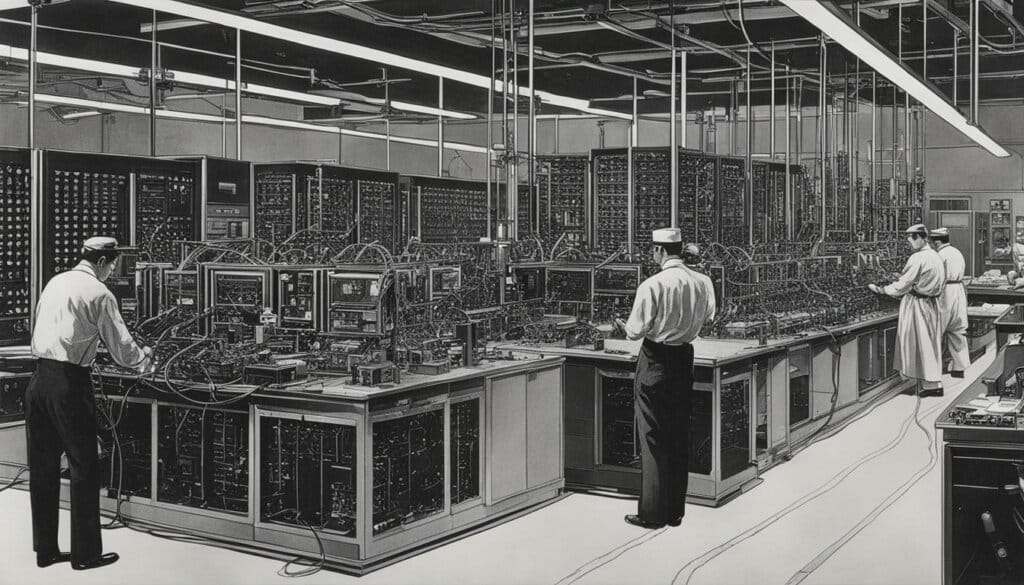
Innovation and Impact
The first generation of processors brought about significant innovation and had a profound impact on the technology industry. They made computing more accessible, affordable, and versatile, leading to the widespread adoption of personal computers. The introduction of the microprocessor concept revolutionized the way computers were built and operated, paving the way for future advancements and the development of more advanced and sophisticated processors.
- Increased Processing Power: First-generation processors significantly increased processing power, enabling more complex calculations and tasks to be performed.
- Memory Capacity: These processors also introduced larger memory capacities, allowing for the storage and retrieval of larger amounts of data.
- Architectural Innovations: The architectural designs of first-generation processors laid the groundwork for future advancements in chip design and computing technology.
The history of first-generation processors is a testament to the rapid progress and innovation that has shaped the modern computing landscape. From the early days of the 4004 microprocessor to the introduction of the 8080 processor and beyond, these processors have laid the foundation for the technology-driven world we live in today.
Future of First Generation Processors
The first generation of processors, although now considered obsolete, has left a lasting impact on the world of computing. These early microprocessors paved the way for the development of more advanced and sophisticated processors, setting the stage for the future of computing technology.
While the first generation processors had limitations in terms of processing speed and memory capacity, their introduction laid the foundation for exponential growth in computing power. Subsequent generations of processors built upon the advancements and innovations of their predecessors, leading to the development of faster, more efficient, and capable processors.
Today, the future of first generation processors lies in their historical significance and the lessons they taught us. These processors demonstrated the potential of microprocessors and showed that computing can be made accessible and affordable. They sparked a revolution in the technology industry, leading to the widespread adoption of personal computers and the establishment of Intel as a market leader in the processor industry.
The Legacy of First Generation Processors
While the first generation processors may no longer be in use, their influence can still be seen in modern computing devices. The lessons learned from these early processors continue to shape the direction of processor development, with each new generation building upon the advancements and innovations of the past.
As technology continues to evolve, the legacy of first generation processors serves as a reminder of the progress made and the potential for future advancements. These early pioneers of computing have paved the way for the development of more powerful and efficient processors, enabling us to perform complex tasks and push the boundaries of what is possible.
| Generation | Key Advancements |
|---|---|
| First Generation | Introduction of microprocessors, paving the way for modern computing |
| Second Generation | Improved processing speed and memory capacity |
| Third Generation | Introduction of integrated circuits, leading to smaller and more efficient processors |
| Fourth Generation | Development of more powerful and specialized processors |
The future of first generation processors is not in their physical use, but rather in the lessons they have taught us and the foundation they have laid. The advancements made in processing power, memory capacity, and architectural design have transformed the world of computing and continue to shape the technology-driven world we live in today.
Conclusion
The first generation of computer processors marked a significant milestone in the evolution of computing technology. These processors revolutionised the industry by introducing the concept of a microprocessor and demonstrating its potential. They played a crucial role in making computing more accessible and affordable, laying the foundation for the development of personal computers. The advancements in processing power, memory capacity, and architectural design set the stage for future generations of processors. The legacy of first-generation processors continues to shape the technology-driven world we live in today.
While first-generation processors have become obsolete in modern computing devices, their impact and contributions to the field of technology cannot be overlooked. These processors laid the foundation for the exponential growth in computing power and paved the way for the development of more advanced and sophisticated processors. The concept of a microprocessor, first introduced in the first generation, continues to be the backbone of modern computing systems. As we move forward, new generations of processors build upon the advancements and innovations of the past, driving us towards greater computational power and technological achievements.
The history of first-generation processors is closely intertwined with the development of personal computers and the evolution of the technology industry. From the introduction of the Intel 4004 microprocessor to the widespread adoption of the 8080 processor, these early chips shaped the landscape of computing. The legacy of the first generation of processors can be seen in the modern devices and technologies that we use today. As we look to the future, it is important to acknowledge and appreciate the foundational role that the first generation of processors played in shaping the world of computing as we know it.
FAQ
What is the first generation of computer processors?
The first generation of computer processors refers to the initial wave of microprocessors that were introduced in the late 1960s and early 1970s.
Who created the first microprocessor?
Intel is credited with creating the first microprocessor, the 4004, in 1971.
What were some popular processors before Intel’s microprocessor?
Other popular processors before Intel’s microprocessor included the Z-80 and 6502, which were widely used in personal computers.
What role did the 8080 processor play in starting the PC revolution?
The 8080 processor, used in the first personal computer, the Altair 8800, played a crucial role in starting the PC revolution.
What were the key features of the first generation of processors?
The first generation of processors typically had 8-bit architecture, limited memory capacity, and relatively low clock speeds. They also introduced new instructions and addressing modes.
How did the first generation of processors impact the development of modern computing?
The first generation of processors laid the foundation for future advancements in technology by introducing the concept of a microprocessor. They made computing more accessible and affordable and set the stage for competition and innovation in the processor industry.
What were the advantages of first-generation processors?
The advantages of first-generation processors included their compact size, low cost, improvements in processing speed and memory capacity, backward compatibility with older software, and enhanced versatility with new instructions and addressing modes.
What were the limitations of first-generation processors?
The limitations of first-generation processors included lower processing speeds, limited memory capacity, more complex programming requirements, and a higher risk of failures and overheating due to the use of older technologies.
How did first-generation processors contribute to the evolution of computing technology?
The first generation of processors marked the beginning of a continuous evolution in computing technology, with subsequent generations introducing improvements in processing power, memory capacity, and architectural design.
What is a first-generation CPU?
A first-generation CPU refers to the initial wave of microprocessors that were introduced in the late 1960s and early 1970s. These CPUs were the building blocks of early computer systems.
How did first-generation computer processors shape the modern computing industry?
The first generation of computer processors paved the way for advancements in processing power, memory capacity, and software development. They were instrumental in bringing computing power to smaller devices and making computing more accessible to a wider audience.
What is the future of first-generation processors?
While first-generation processors have become obsolete in modern computing devices, their impact and contributions to the field of technology cannot be overlooked. The legacy of first-generation processors continues to shape the future of computing, with new generations building upon past advancements and innovations.

